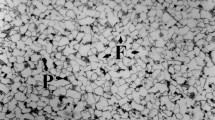Abstract
Dilatometry and cooling curve analysis (CCA) are two methods of determining the evolution of a phase transformation with temperature. The two methods are similar conceptual in that they take an indirect measure of the transformation and extract phase fraction information from it; however, the differences between the two methods typically makes one method better suited to analyzing a given transformation. However, without a quantitative comparison between the two methods, it is difficult to use them interchangeably. We address this by presenting a quantitative comparison of CCA and dilatometry for a martensitic transformation in a 9Cr3W3CoVNb steel. The resulting phase fraction data matches very well, within 5 K (5 °C) for any given phase fraction. This paper also extends to the quantitative methodology of calorimetry to the analysis of dilatometric data, with results comparable to ASTM A1033-10, but with expected higher accuracy by accounting by variable thermal expansion coefficients.





Similar content being viewed by others
References
T.C. Tszeng, G. Shi, Mater. Sci. Eng. A 380, 123–136 (2004)
A.I.Z. Farahat, J. Mater. Process. Technol. 204, 365–369 (2008)
A. Bojack, L. Zhao, P. Morris, J. Sietsma, Mater. Charact. 71, 77–86 (2012)
A. Kiani-Rashid, D. Edmonds, Mater. Sci. Eng. A 481–482, 752–756 (2008)
J.W. Gibbs, P.F. Mendez, Scripta Mater. 58, 699–702 (2008)
J.W. Gibbs, M.J. Kaufman, R.E. Hackenberg, P.F. Mendez, Metall. Mater. Trans. A 41A, 2216–2223 (2010)
R.C. MacKenzie, Differential Thermal Analysis (Academic Press, London, 1970)
B.T. Alexandrov, J.C. Lippold, Weld. World 51, 48–59 (2007)
J. Tamminen: Ph.D. Thesis, University of Stockholm, 1988.
M. Kiuchi, S. Sugiyama, Ann. CIRP 43, 271–274 (1994)
S.I. Bakhtiyarov, M. Dupac, R.A. Overfelt, S.G. Teodorescu, J. Fluids Eng. 126, 468–470 (2004)
J.I. Frankel, W.D. Porter, A. Sabau, J. Therm. Anal. Calorim. 82, 171–177 (2005)
D.M. Stefanescu, G. Upadhya, D. Bandyopadhyay, Metall. Trans. A 21A, 997–1005 (1990)
P. Mayr: Ph.D. Thesis, Graz University of Technology, 2007.
P. Mayr, T. Palmer, J. Elmer, E. Specht, S. Allen, Metall. Mater. Trans. A 41A, 2462–2465 (2010)
P. Mayr, Weld. World 54, R1–R11 (2013)
P. Mayr, T.A. Palmer, J.W. Elmer, E.D. Specht, Int. J. Mater. Res. 99, 381–386 (2008)
ASTM A1033-10: Referencing: ASTM International, Designation: A 1033–10, pp. 1–14, 2013.
T.L. Bergman, F.P. Incropera, A.S. Lavine, D.P. DeWitt, Fundamentals of Heat and Mass Transfer (Wiley, New York, 2011)
D.R. Poirier, G.H. Geiger, Transport Phenomena in Materials Processing (Wiley, New York, 2013)
P.F. Mendez, J. Appl. Mech. 77, 61017112 (2010)
JAHM: Material Property Database (MPDB v6.61), 1999.
M. Peet, H. Hasan, H. Bhadeshia, Int. J. Heat Mass Transf. 54, 2602–2608 (2011)
Thermo-Calc Software TCFE6 Steels/Fe-alloys database Version 6.2, 2013.
M. Gojić, M. Sućeska, M. Rajić, J. Therm. Anal. Calorim. 75, 947–956 (2004)
Acknowledgments
The authors would like to acknowledge the Natural Sciences and Engineering Research Council of Canada (NSERC), Codes And Standards Training Institute (CASTI) and MITACS for their support of this exploratory work.
Author information
Authors and Affiliations
Corresponding author
Additional information
Manuscript submitted April 14, 2014.
Appendix: Estimation of Temperature Gradients in a Dilatometry Sample
Appendix: Estimation of Temperature Gradients in a Dilatometry Sample
Typically in dilatometry, the temperature is measured with a thermocouple welded to the surface of the metal sample. During free cooling of a metal dilatometry sample, a slight difference exists between the temperature of the core of the sample and its surface.
From an energy balance on the surface of the sample (heat transfer due to conduction equal to heat transfer due to convection) and assuming heat losses are only through the sides of the cylindrical sample, which is typically the case in a push rod dilatometer, Eq. [16] can be rewritten as:
This equation can then be simplified to:
In this case \(\bar{c_{{\text{p}}}}\) is the average heat content in the transformation range \(\left( \bar{c_{{\text{p}}}}=\frac{H^*_2-H^*_1}{T_2-T_1}\right), \) where \(H^*_2\) and \(T_2\) relate to the enthalpy and temperature at the start of the transformation and \(H^*_1\) and \(T_1\) relate to values at the end of the transformation. The corresponding thermal diffusivity is \(\bar{\alpha }=\frac{k}{\rho \bar{c_{{\text{p}}}}}\). Values for the thermophysical properties used in this calculation are listed in Table IV. Temperature homogeneity is crucial to the analysis techniques presented here. The degree to which a sample is spatially isothermal is captured by the Biot number (\({\rm{Bi}}=\frac{\bar{h}R}{k}\)).[19] For small Bi numbers \(\left( \frac{\bar{h}R}{k}\ll 1\right) \), the temperature profile can be considered to be nearly homogeneous, decreasing uniformly at all points with time.[20] A nearly uniform temperature distribution can be captured well with a second order polynomial. According to Reference 21, the gradient at the surface could then be estimated as:
Considering a long cylinder:
then,
The value of \(\bar{h}\) was estimated from the high temperature, single phase data using a value of \( c_{{\text{p}}} \approx 500\,{\text{J/kg}}\,{\text{K}} \).[24,25] A value for \(\bar{c_{{\text{p}}}}\) was determined by using a transformation temperature range of 225 °C to 400 °C. Using Eq. [A5], the maximum temperature difference is \(\Delta T_{\max} \approx 0.1\,^{\circ }{\rm C}\) in the transformation temperature regime, indicating that the spatially isothermal assumption is valid.
Rights and permissions
About this article
Cite this article
Gibbs, J.W., Schlacher, C., Kamyabi-Gol, A. et al. Cooling Curve Analysis as an Alternative to Dilatometry in Continuous Cooling Transformations. Metall Mater Trans A 46, 148–155 (2015). https://doi.org/10.1007/s11661-014-2603-8
Published:
Issue Date:
DOI: https://doi.org/10.1007/s11661-014-2603-8




